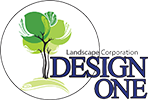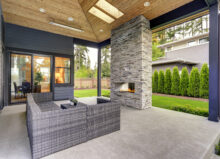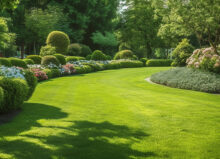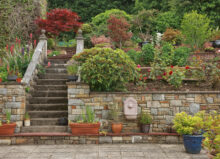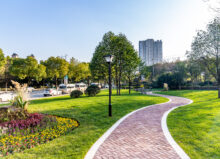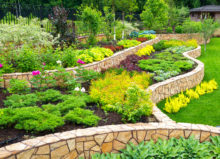Landscape Designs to Impress: How to Stand Out in Your Neighborhood
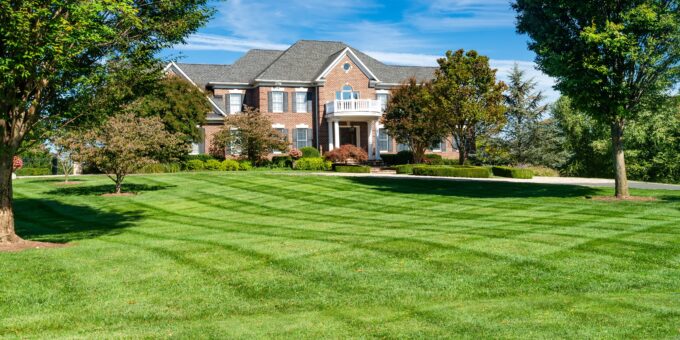
A well-manicured, green, and lush lawn isn’t enough for today’s homeowners. More homeowners now want a unique, low-maintenance landscape design that accentuates their style and improves functionality.
If you’re looking for ways to improve your existing landscape, you need to familiarize yourself with the basic elements of landscape design. In this article, we’ll cover what those elements are and provide tips on improving your landscape based on each element.
Landscaping Tips by Design Element
Balance, transition, and focalization are overarching landscape design principles. However, the true beauty of a home’s landscape is found in the five details of color, form, texture, and scale.
Too much of any one element, or an unstructured use of all five elements, can make a residential landscape boring or chaotic. Even natural landscape designs are an ordered use of wildflowers, native plants, and stones that seem random but have a reason and a goal.
Let’s take a closer look at these elements and what you can do to apply them to your landscape design effectively.
1. Color
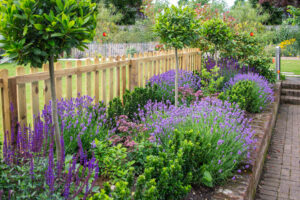
Flowers, shrubs, and trees can draw attention to the home, blend and balance the home with the yard, or add emotional contrast, such as a cooler feel to classic home styles or warmer tones to modern styles.
Color is one of the easiest elements to add to a landscape because flowers can be easily planted in-ground or used in containers. If you want to draw attention to a particular point of the landscape, consider one stand-out color, like an extraordinary flowering bush or tree.
If it is color excitement you’re looking for, consider planting a variety of wildflowers that bloom at different times versus having a few sparse plants that are the same color.
Likewise, if you want a less chaotic and more uniform color scheme, find flowers that are different shades of the same color—that way, there is still some variety.
2. Form
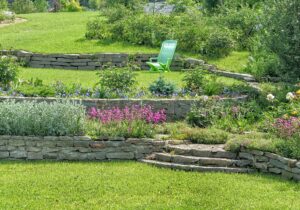
Unlike color, form is a three-dimensional landscape design trick that adds an unconscious attractiveness to any yard. Form comes in many varieties, such as a balanced flow between outdoor areas or the contrast between larger hardscaped areas and smaller softscape elements, such as hedges, trees, and foliage.
Hardscaped structures add form and define the shape. Examples of hardscaping include outdoor fireplaces, retaining walls, walking paths, stone patio areas, decks and seating, and water features. Form can also prevent a landscape from appearing stark. For example, rounded, natural forms like large stones can soften hardscaped areas.
3. Line
In landscape design, the definition of ‘line’ is the intentional use of curves and straight lines (horizontal and/or vertical) to add definition or structure to a landscape. Consider curved pathways or rounded hedges, vertical fencing or tall, thick trees, and horizontal overhead patio shades, which can create visual lines of interest.
Landscape lines can lead the eye toward a distant feature or provide a path to another outdoor scene. Using straight lines is a good option for homeowners who desire a more orderly and uniform landscape. Curved lines of interest (such as a curved-edged flower garden) are more creative and visually appealing.
4. Texture
Texture is a fun design principle to work with and can be created with fine, tall grassy areas or fern-like plants, thick and low ground cover or clumps of hostas, pine needle beds, gravel and fine stone areas, or mulch tree beds. Ground cover should feature texture that can provide visual interest and a unique contrast to flowers and other plants in a garden.
Many ground covers don’t require much sunlight and feature different textures, including matted, spiked, clumped, or spreading. Many of these forms of ground cover also double as weed-control elements or add visual appeal in areas where grass refuses to grow.
5. Scale
Finally, scale is essential to prevent a landscape design that is either overwhelming or underwhelming. Consider the size of your home and yard when adding landscaping features, and opt for plant and tree varieties in amounts that will not give your home an overcrowded look. A smaller home might opt for a simple Red Japanese Maple tree, while a number of larger trees are appropriate for a spacious front yard.
While the goal of scale is to avoid overcrowding with too many features in one area, the same applies to minimalist landscaping. A large home with only foundation border flowers, short hedges, and a few small trees will not be enough to make the landscape stand out.
Achieve Unity & Balance By Working With a Professional
Applying all the elements of landscaping design is a science and an art. Landscape design mistakes can create an imbalance between outdoor elements and the home or create a landscape that doesn’t fit the size or style of the home. And once a landscape is installed, removing those items can be tedious, time-consuming, and costly.
Work with a professional like Design One if you’re considering upgrading or redoing your landscape. We have over 30 years of experience handling residential and commercial landscape design and installation projects across Michigan.
You can view some of our past projects here. If you’re ready to start your next project, contact us today to schedule a free consultation.
